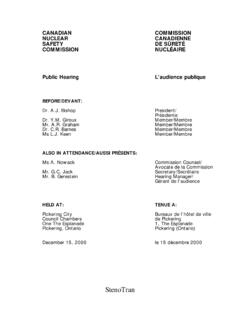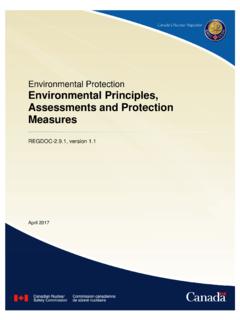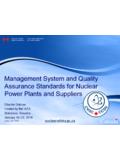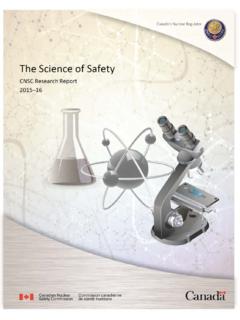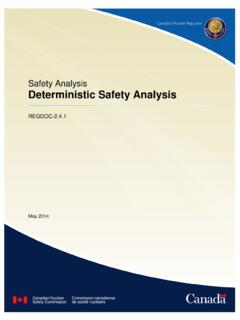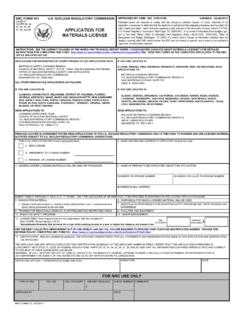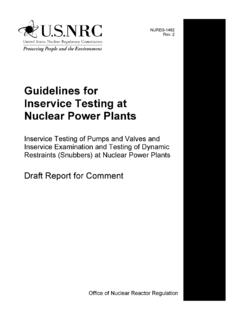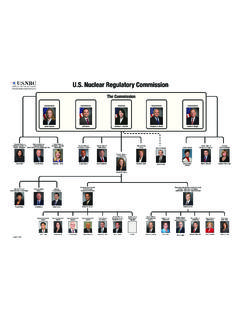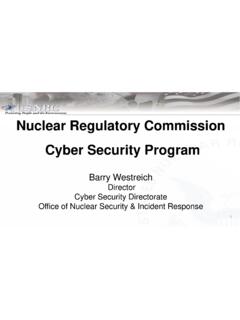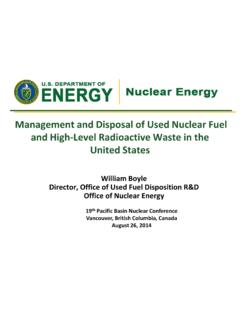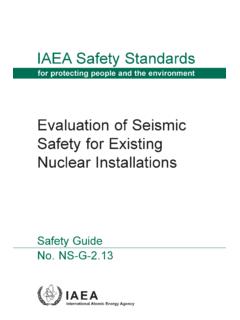Transcription of Regulatory Guide G-129, Rev. 1, Keeping Radiation ...
1 Regulatory Guide Keeping Radiation Exposures and Doses "As Low as reasonably achievable (ALARA)" G-129, REVISION 1 October 2004 Regulatory DOCUMENTS The legal framework within which the Canadian nuclear Safety commission (CNSC) operates includes the nuclear Safety and Control Act (Act), its Regulations and other legal instruments such as licences, certificates and orders. The legal framework is supported by Regulatory documents issued by the CNSC, the main classes of which are Regulatory Policy (P): a document that describes the philosophy, principles or fundamental factors that underlie the CNSC s approach to its Regulatory mission. It provides direction to CNSC staff and information to stakeholders. Regulatory Standard (S): a document that describes CNSC requirements. It imposes obligations on the regulated party, once it is referenced in a licence or other legally enforceable instrument.
2 Regulatory Guide (G): a document that indicates acceptable ways of meeting CNSC requirements, as expressed in the Act, Regulations, Regulatory standard or other legally-enforceable instrument. It provides guidance to licensees and other stakeholders. Regulatory Notice (N): a document that provides licensees and other stakeholders with information about significant matters that warrant timely action. Regulatory Guide G-129, Revision 1 Keeping Radiation EXPOSURES AND DOSES "AS LOW AS reasonably achievable (ALARA)" Published by the Canadian nuclear Safety commission October 2004 Keeping Radiation Exposures and Doses "As Low as reasonably achievable (ALARA)" Regulatory Guide G-129, Revision 1 Published by the Canadian nuclear Safety commission Minister of Public Works and Government Services Canada 2004 Extracts from this document may be reproduced for individual use without permission, provided the source is fully acknowledged.
3 However, reproduction in whole or in part for purposes of resale or redistribution requires prior written permission from the Canadian nuclear Safety commission . Catalogue number: CC173-3/2-129-1E ISBN 0-662-38407-5 Ce document est galement disponible en fran ais sous le titre Maintenir les expositions et les doses au niveau le plus bas qu il soit raisonnablement possible d atteindre (ALARA) . Document availability The document can be viewed on the CNSC Internet website at Copies may be ordered in English or French using the contact information below: Communications and Information Management Directorate Canadian nuclear Safety commission Box 1046, Station B 280 Slater Street Ottawa, Ontario, K1P 5S9 Telephone: (613) 995-5894 or 1 800 668-5284 (Canada only) Facsimile: (613) 992-2915 E-mail: October 2004 G-129, Revision 1 TABLE OF CONTENTS PURPOSE.
4 1 SCOPE .. 1 RELEVANT LEGISLATION .. 1 INTRODUCTION .. 2 SOCIAL AND ECONOMIC FACTORS .. 3 ALARA: MAGNITUDE OF EFFORT AND DOSE LEVELS .. 3 APPROACH TO ALARA .. 3 Management Control over Work 3 4 Oversight of the Radiation Protection Program .. 4 Personnel Qualification and 4 4 Training .. 4 Control of Occupational and Public Exposure to 5 Resources .. 5 Operational Reviews .. 5 Environmental Monitoring .. 5 Overall Health and Safety .. 6 Planning for Unusual Situations .. 6 Radiological Work Plans .. 6 Other 6 Documentation .. 7 Radiological Performance 7 JUDGEMENT OF REASONABLENESS .. 7 Source .. 7 7 Good Practice .. 8 Feasibility .. 8 8 9 October 2004 G-129, Revision 1 1 Keeping Radiation EXPOSURES AND DOSES "AS LOW AS reasonably achievable (ALARA)" PURPOSE This Regulatory Guide helps persons regulated by the Canadian nuclear Safety commission (CNSC), when implementing a Radiation protection program, to keep the amount of exposure to radon progeny and the effective dose and equivalent dose received by and committed to persons as low as reasonably achievable , social and economic factors being taken into account (ALARA).
5 SCOPE This document describes measures that regulated persons can take for the purpose of Keeping the amount of exposure to radon progeny and the effective dose and equivalent dose received by and committed to persons as low as reasonably achievable , social and economic factors being taken into account (ALARA). This Regulatory Guide G-129, , Keeping Radiation Exposures and Doses As Low as reasonably achievable (ALARA) supersedes the Regulatory Guide G-129, Guidelines on How to Meet the Requirement to Keep All Exposures As Low As reasonably achievable published in September 1997. RELEVANT LEGISLATION The following provisions of the regulations made under the nuclear Safety and Control Act are relevant to this Guide : 1. Paragraph 4(a) of the Radiation Protection Regulations requires every licensee, as part of a Radiation protection program, to keep the amount of exposure to radon progeny and the effective dose and equivalent dose received by and committed to persons as low as is reasonably achievable , social and economic factors being taken into account, through the implementation of (i) management control over work practices, (ii) personnel qualification and training, (iii) control of occupational and public exposure to Radiation , and (iv) planning for unusual 2.
6 Subsection 18(1), of the Packaging and Transport of nuclear Substances Regulations obliges every consignor, carrier, and consignee of radioactive material to implement a Radiation protection program, and, as part of that program to G-129, Revision 1 October 2004 2 (a) keep the amount of exposure to radon progeny and the effective dose and equivalent dose received by and committed to persons as low as is reasonably achievable , social and economic factors being taken into account, through the implementation of (i) management control over work practices, (ii) personnel qualification and training, (iii) control of occupational and public exposure to Radiation , and (iv) planning for unusual situations; (b) prevent persons from receiving doses of Radiation higher than the dose limits prescribed by the Radiation Protection Regulations; and (c) train persons referred to in the program on the application of the program.
7 INTRODUCTION The Radiation Protection Regulations require licensees to implement measures to keep doses received by workers and members of the public from exposure to sources of Radiation ALARA. It is insufficient for a licensee to simply respect the appropriate dose limits; efforts must be made to further reduce doses. The senior management of a licensee is expected to be committed to the concept of maintaining doses ALARA and to take appropriate measures to reduce doses where practical. The ALARA concept is not new. It has been incorporated into the recommendations of the International commission on Radiological Protection for a number of years. The Radiation Protection Regulations extend this requirement to all licensees, and the CNSC seeks explicit demonstration of compliance. This document guides licensees on the type of action that aims to effectively control and minimize doses.
8 It outlines the importance of an explicit commitment by senior management to limit doses to magnitudes that are ALARA, the need for suitable programs to achieve this objective, and the value of reviewing work-related doses periodically to ensure that they continue to be adequately controlled. The CNSC, among other things, looks at the processes adopted by licensees to maintain doses ALARA as evidence of compliance with paragraph 4(a) of the Radiation Protection Regulations. Accordingly, licensees may be required to identify the process by which they maintain doses ALARA. CNSC staff verify the licensee s adherence to this process from time to time. The CNSC believes that the application of sound Radiation protection principles by well-trained employees will be, in most instances, all that is required to maintain doses ALARA. This document includes information that pertains to all phases of an operation s life cycle, from site selection through to decommissioning.
9 The transportation of radioactive materials also falls within the scope of this document; those responsible for such October 2004 G-129, Revision 1 3 transportation can review this document to determine which elements pertain to their particular situation. Detailed descriptions of the measures that may be necessary to comply with the regulations are beyond the scope of this document. SOCIAL AND ECONOMIC FACTORS The ALARA concept takes into consideration relevant social and economic factors. These could include, for example, the financial impact of protection measures as balanced against the benefit obtained. The views of the public are also relevant. ALARA: MAGNITUDE OF EFFORT AND DOSE LEVELS ALARA incorporates the notion that the magnitude of effort that should be applied to control doses depends on the magnitude of projected or historical doses.
10 Managers should review dose levels on a continuous basis to ensure they are ALARA. Licensees are expected to reduce doses where this can be done without significant expenditures. To minimize the commitment of resources that are likely to have a poor return in safety improvement, the CNSC may consider that an ALARA assessment, beyond the initial analysis, is not required in the following circumstances: 1. individual occupational doses are unlikely to exceed 1 mSv per year, 2. dose to individual members of the public is unlikely to exceed 50 Sv per year, and 3. the annual collective dose (both occupational and public) is unlikely to exceed 1 person-Sv. Considering doses to members of the public addresses situations where a limited number of people may receive significant fractions of the individual dose limit even if the collective dose is low ( , less than 1 person-Sv). In such situations, additional Radiation protection measures may still be required.

